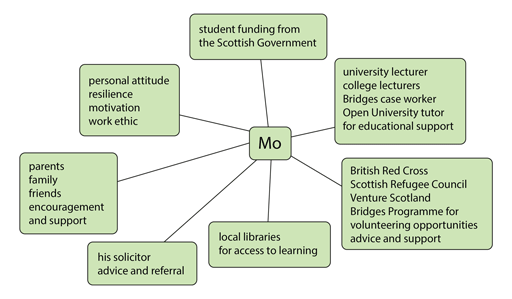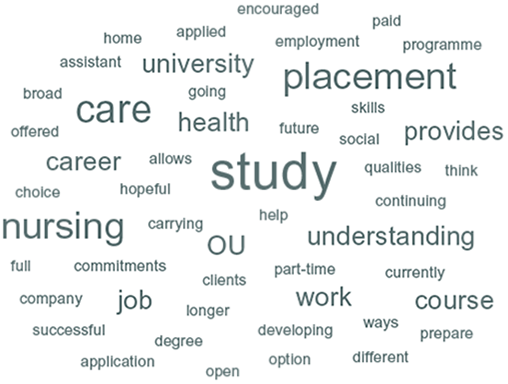Use 'Print preview' to check the number of pages and printer settings.
Print functionality varies between browsers.
Printable page generated Saturday, 22 November 2025, 11:56 PM
Session 5: Identifying my next steps and where I can find information and support
Introduction

You have been looking at how to start working towards your goals, and how you can help yourself. You now have an idea of where you want to get to and what difficulties there might be. You also know what aspects of your life might help you. We all need some help in getting to where we want to be in life. Are there people you know who can also help you and support you: family members, friends, fellow students, work colleagues or people you have met through organisations you have had contact with or activities you have taken part in?
Look at the spider diagram in Figure 5.2, which shows who helped Mo to achieve his aims.
Now listen to Mo’s story and about the help he received.
Transcript
My parents encouraged me to go to university and I graduated in natural resources engineering at university in Iran. An event happened to me and so I had to flee the country and come to the UK. I went to London, Heathrow Airport, and after two or three days they sent me to Glasgow.
My first experience at the airport wasn’t good. I remember then I couldn’t speak a word and I didn’t know where I was. When I was in London, in the morning they sent me to Glasgow, arriving about 8 p.m. at night. I can’t remember the time exactly. We were sitting on a bus for about ten hours and didn’t get anything to eat.
They took me to the YMCA. We were hungry and they just gave us some money and said in the morning to go out shopping. You know, we survived, me and my friend. We kind of met each other on the bus and so became friends.
It took me about six months to settle in. In the YMCA I met someone from the British Red Cross. From the British Red Cross I went to Venture Scotland, doing some activities. It was good.
There were lots of problems in Glasgow and after one year I decided to move to London. At that time I got my ‘Status’ in 2008. I tried to stay in London but I couldn’t because there wasn’t any support. It was just a big, crazy city so I decided I had to come back to Glasgow. When I came back from London I had started working with the British Red Cross. I went on their journalist workshops and journalist short course, and after that I started working with New Voices.
My solicitor sent me to the Scottish Refugee Council and they introduced me to the Bridges Programmes. Bridges helped me to find some subjects at The Open University. During my study at college on ESOL and HNC/HND computing, I was doing some of their units such as Learning to change and Starting with maths. Bridges helped me with my finance, applying for SAAS. This year they helped me find a security job with G4S for the summer holidays.
I am still struggling financially. It is really difficult. Every year it changed. I would say for my education, finding a job, Bridges has been supportive. I can say every time I had problems and I needed some advice I just picked up the phone and asked Bridges.
When I went to college and was studying ESOL and HNC computing, college was really supportive, especially my lecturers. The HNC finished and then I started studying HND. I finished the HND and I started university last year. Scotland is a good place. Hopefully I will just finish my study and move to another city.
Your support and next steps
Have you had help from others in the same way as Mo? Are there people in your life now whom you think will help you towards achieving your aims?
Activity 5.1 My support networks
Think about the people who have helped you or who might help you in the future with any plans you have.
You can make a spider diagram like the one for Mo – on paper or online by going to bubbl.us. The bubbl.us website has instructions on how to use this free online tool. If you prefer not to use this, or don’t have access to the internet, don’t worry – pen and paper will do just as well.
Use your notebook or the the activity sheet provided.
OR
Go to Activity 5.1 of your Reflection Log. Once you have completed the activity, make sure you save the document again.
Then, if you want to, share your spider diagram with the others in your group and discuss it with them. Alternatively, share it online by posting it on an online forum or via social media.
You have nearly reached the end of this course. Activity 5.2 involves planning the next move towards your goals – you need to think carefully about where you are trying to get to.
Remember, there is a lot of information and advice available if you would like further guidance on planning your future, or if you would like help with issues that this reflecting on your experiences has raised for you. You can visit The Open University’s Careers Advisory Service, or any of the websites listed in the Resources section.
Activity 5.2 My long-term goal and first ‘next step’
Starting from now and where you are at the moment, think very carefully about what you need to do to get to where you want to be. Think back on the activities you have done, and what you have learned from:
- your past experiences (Activity 2.3)
- the skills, qualities and abilities you have (Activity 3.2)
- anything that will help you, as well as any difficulties you may need to overcome (Activities 4.3 and 4.4)
- any people that you know will be there to help you (Activity 5.1).
Fill in a table with your long-term goal and the actions you will take to achieve it. Use this information to write a sentence starting ‘The first step I am going to take ...’.
OR
Go to Activity 5.2 in your Reflection Log. Once you have completed the activity, make sure you save the document again.
Share your plan and your sentence with the others in your group or online if you want to, or you can just share your sentence if you prefer.
If you would like to, you can make a ‘word cloud’ out of your sentence. This shows you which words were used most often and are therefore the most important to you. Figure 5.3 is a word cloud of what Eric, whom you met in Session 3, wrote in his plan.
To make your own word cloud, go to TagCrowd or your Reflection Log. If you haven’t used TagCrowd before, click on the ‘Help’ page included on the site.
Note that The Open University is not responsible for third party websites or the information you choose to share with them.
If you prefer not to use this tool, or don’t have access to the internet, don’t worry – pen and paper will do just as well. Write down your answer for Activity 5.2 and then read it over. Pick out or underline what you think are the key (most important) words for you.
Review your table
To help you summarise what you have gained from your reflections, we’d like you to return to the table you created in Session 1.
Activity 5.3 Review my table

In the introduction to this course we said that ‘reflection is a way of working on what we know already and it generates new knowledge’. Revisiting the table you completed in Session 1 is a means to assess this process of reflection. If you saved a copy of the table, keep it handy as you will need it at the end of this activity.
Take another look at Ying’s table to remind you.
| How do I see myself now? | What makes me happy? |
|---|---|
Trying to work, earn, study for a better future Spend time with my daughter | Being successful in study Having work I enjoy Spending time with my daughter Having friends from other countries and cultures |
| What am I most proud of? | How would I like to see myself in the future? |
How much I have achieved since arriving in the UK Gaining further education qualifications Finally I feel like I fit into the community around me | Being able to manage my time better Having more speaking and writing skills in English To progress in my job at work To be involved in helping other people who started out in the same situation as me |
As you did in Session 1, fill in the boxes on the table we have provided for you.
OR
Go to Activity 5.3 of your Reflection Log. Once you have completed the activity, make sure you save the document again.
If you are working in a group and you would like to share your answers, you can show them to other members. If you want to share them electronically, save your answers first and email them or put them online by posting them on an online forum or via social media.
When you have completed your table, compare it with the one that you completed in Session 1.
- Is it the same?
- Are there any changes?
It may be very similar or it may be quite different. Reflection is a continuous process that may not necessarily bring about immediate changes, but it may lead to subtle differences in our thinking about ourselves, our plans and our goals that will emerge over time.
Final activity
Your final activity is to summarise briefly what you have gained from this course.
Activity 5.4 What have I learned?

Here are the learning outcomes that we listed in this course’s introduction:
- an understanding of the strengths, qualities and skills gained by new migrants, refugees and asylum seekers during periods of transition
- a clearer understanding of the experiences that learners could have reflected on, including their roles, actions and decisions
- an idea of what direction learners might like to go in now
- an idea of how to find out what is possible for learners to achieve in the immediate future
- the ability to use information technology (IT) to carry out simple activities in writing and communicating
- the ability to use the internet to find information useful to learners
- the ability to use new ways of expressing ideas.
Make a note of the learning outcomes that you think you’ve achieved, either fully or partially. Also write down anything else you feel you have achieved that was not in them, such as making some new friends, learning that everybody has difficulties of some kind, etc.
You can use the table provided to complete this activity.
OR
Go to Activity 5.4 of your Reflection Log. Once you have completed the activity, make sure you save the document again.
We hope you have enjoyed studying the course and working through the optional course quizzes to gain your digital course badge. We hope you have learned a little bit more about yourself: how much you can do and what you would like to do in the future. Everyone has strengths, qualities and abilities, and we sometimes need help in recognising and using these. We hope you will go on to achieve great things with your talents!
If you have studied this course as a support worker, we hope you have learned more about the challenges and issues that new migrants, refugees and asylum seekers face while living and trying to study and/or work in the UK.
Quiz
To conclude this part of the course and consolidate your learning you may like to complete the fifth quiz.
Quiz 5 provides evidence that you are achieving the following learning outcomes:
- an understanding of the strengths, qualities and skills gained by new migrants, refugees and asylum seekers during periods of transition
- a clearer understanding of the experiences that learners could have reflected on, including their roles, actions and decisions
- an idea of what direction learners might like to go in now
- an idea of how to find out what is possible for learners to achieve in the immediate future
- the ability to use information technology (IT) to carry out simple activities in writing and communicating
- the ability to use the internet to find information useful to learners
- the ability to use new ways of expressing ideas.
If you need a reminder about the quizzes and the criteria for getting a badge, visit How to complete the course quizzes.
Next steps
After completing this course you may wish to study an OpenLearn study unit or find out more about reflection.
- Am I ready to study in English? (EAL_1)
- Using voluntary work to get ahead in the job market (Vol_1)
- Working life and learning (BU130_1)
- Learning to change (Y165_1)
- OpenLearn Scotland
If you wish to study formally at The Open University, you can find out more at:
For further support or advice you could contact an organisation such as Bridges Programmes to discuss your plans.
Acknowledgements
Reflecting on Transitions was developed by Lindsay Hewitt and Christine McConnell of The Open University in Scotland in collaboration with Bridges Programmes. The optional quizzes for the related digital course badges for learners and support workers, respectively, were developed by Julie Robson (The Open University) and Jonathan Sharp (Bridges Programmes). The course was edited by Lindsay Hewitt and Jennifer Nockles (The Open University).
We are hugely grateful to Bridges’ clients, Mo, Ying, Eric and Natalia, whose stories have informed the development of this course and bring to life the activities within it.
Except for third party materials and otherwise stated (see terms and conditions), this content is made available under a Creative Commons Attribution-NonCommercial-ShareAlike 4.0 Licence.
The material acknowledged below is Proprietary and used under licence (not subject to Creative Commons Licence). Grateful acknowledgement is made to the following sources for permission to reproduce material in this unit:
Images
Figure 5.1: © iStockphoto.com
Figure 5.4: © iStockphoto.com
Figure 5.5: Gwetterkind/Istockphoto.com
Every effort has been made to contact copyright owners. If any have been inadvertently overlooked, the publishers will be pleased to make the necessary arrangements at the first opportunity.
Don’t miss out:
1. Join over 200,000 students, currently studying with The Open University – http://www.open.ac.uk/ choose/ ou/ open-content
2. Enjoyed this? Find out more about this topic or browse all our free course materials on OpenLearn – http://www.open.edu/ openlearn/
3. Outside the UK? We have students in over a hundred countries studying online qualifications – http://www.openuniversity.edu/ – including an MBA at our triple accredited Business School.

